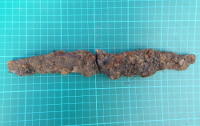18 Jul 2016
Forty Hall Summer Dig - Day 6

It was a tiring end to the final day of our week-long summer dig in Forty Hall, as we finished recording the interior of our palace building in what turned out to be the hottest day of the dig if not the year so far, but as ever our efforts were rewarded with fascinating finds and more crucial information about the structure of the building.
We put out a last-minute five-metre extension to the west of the trench in an effort to find some sign of the western end of the building but this drew a blank, confirming our suspicions that the footprint of the structure is much larger than we had imagined.
Similarly, an extension to the north only revealed more of the pebble and chalk surface we found on the north side of our probable staircase, failing to show any signs of a large exterior wall to parallel the one we found last year and the year before, which held the garderobes.

Meanwhile, the eastern trench extension we opened on Saturday had more success and did eventually find an end if not to the building then at least to the room on the east of the main trench, as it disclosed a T-junction to the small east-west wall which marked the boundary between the pebble and chalk surface and the mortar bedding which held the glazed tile floor. These walls were again quite narrow and relatively insubstantial.
It's too early to be sure, but we're beginning to suspect that this building may not be as solidly constructed as we thought, perhaps even being a half-timbered structure built againt the hefty palace boundary wall. This will be a question for post-excavation analysis and will perhaps lead into next year's work.

The enigma of the iron tool concentration continued in the eastern trench extension -- we've now amassed a wide range of esoteric iron lumps, only one of which (the hammer head) we can currently confidently identify. Most of the objects are unsurprisingly very badly corroded and very fragile -- hopefully after careful cleaning and conservation we'll be able to find out more about them.
Several of the objects look like knife blades although one (pictured) looks as if it may have a regular series of protrusions along one edge (assuming they're not stones rusted to it!) -- perhaps the remains of the teeth of a small rake.

As ever, the answers to this and many other questions raised by this year's work will eventually appear in future editions of Society News.
This year's dig has been an unparalelled success; we've never uncovered so much evidence of a single palace building in such a short space of time, and it represents a crucial phase in the palace's development in the mid sixteenth century, just after its acquisition by Henry VIII that we have not been able to study in detail before.
There are still many more unanswered questions about this part of the palace and its relationship to the rest of the palace complex, and we will very likely look to return to the same area again next year.
We are very grateful to the Enfield Museum Service, the Forty Hall Estate and Enfield Council's Parks Department for their cooperation in one of our most productive year's research to date, and most of all to the hard-core band of diggers who stuck it out in the heat and humidity to help with the thankless task of backfilling and re-turfing the trench.